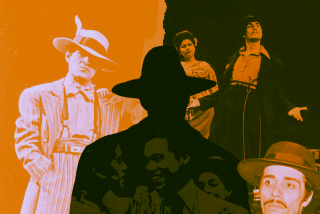Pride of Place : Families, Cultural Mix at Parade Reflect Pacoima’s Roots and Changes
- Share via
PACOIMA — The family of Maria Bayardo Torres took up a good third of a city block, seated one next to the other in lawn chairs along Van Nuys Boulevard on Saturday for the clan’s annual observance of the Pacoima Holiday Parade.
On a glorious Southern California morning, the Bayardos reveled in their togetherness--proud of family matriarch Maria, who raised 10 children, is a grandmother to 28 and great-grandmother to two more--and celebrated the community that has been their home for 27 years.
As they chatted, the parade swept by. Dancers in traditional Aztec dress shook legs adorned with jangling noise-makers. Families in classic Chevrolet Impalas outfitted as lowriders spun doughnuts on the streets and shook up sparks like mini fireworks.
And one of Bayardo Torres’ granddaughters marched by as part of a drill team.
Saturday’s event was the 28th annual parade, sponsored as in years past by the Pacoima Chamber of Commerce. Families crowded the corners and lined Van Nuys Boulevard, and when the music started at about 10:30 a.m.--a little late, but nobody really seemed to mind--a well-traveled San Fernando Valley thoroughfare became a festive place.
As the community strutted its stuff, Bayardo Torres, 62, told the story of her life, revealing a glimpse of Pacoima history along the way.
Born near the pueblo of Dolores Hidalgo in the Mexican state of Guanajuato, Bayardo Torres married at 16 and moved to Ensenada. Later, pregnant with her eighth child, Octavio, she moved with her husband to Pacoima.
They rented a little house on Judd Street, just three blocks from the parade route. They still live there, only now it’s bought and completely paid for, a tribute to her years cleaning houses and her husband’s devotion to two, and sometimes three, jobs.
Life in Pacoima, she said in Spanish, is better than it used to be.
Octavio Bayardo, now 27, pointed down Van Nuys Boulevard to the railroad tracks, where a troupe of African American girls called Ladies First danced in black and white uniforms. The spot, he said, was once infested with crime. Now, thanks to community involvement and an increased police presence, the street is much quieter.
On a corner across from the platform where an announcer called the names of parade participants, a senior citizens residence stood where there had once been a rundown food stand.
Sam Riley, who attended the parade with his pregnant wife, three children and a 6-week-old pit bull puppy named Bone, said he, too, has seen a real change over the past few years.
“It’s a community that has had a hard time pulling itself together, but with the struggle they keep going,” Riley, a 20-year resident, said. “I was away in Indiana for two years, and when I came back, I could really see improvement.”
In the parade, several floats and decorated cars sported the names of African American churches that have anchored the community for decades. In between, a group whose leaders carried Mexican flags burst into rapid-fire Aztec dance steps after one member shouted, “Viva la raza!” the rallying cry for the Chicano movement of the 1960s.
*
The cultural mix reflected a dramatic demographic shift in Pacoima over the past 15 years as Latinos moved into what for decades had been a largely black community.
Bayardo Torres remembers being the only Latina--and the only Catholic--on the block.
“I was afraid to come out into the street,” Bayardo Torres said. “I just stayed in the house with the children.”
Now, she said, 27 years and 27 holiday parades later, neighbors greet one another like old friends.
“Everyone says ‘hi,’ ” she said.
She gestured toward her house, to the people dancing in the street.
“Todos somos humanos,” she said, her eyes bright.
“All of us are human.”
More to Read
Sign up for Essential California
The most important California stories and recommendations in your inbox every morning.
You may occasionally receive promotional content from the Los Angeles Times.













